Stuck on a DNA match? Can't figure out how you are related, even though you both have great trees? A useful strategy called chromosome painting is made easy with a tool called "DNA Painter".
In this post, you'll learn how you can use DNA Painter to find out exactly which line of your family tree to look for your connection with a DNA match.
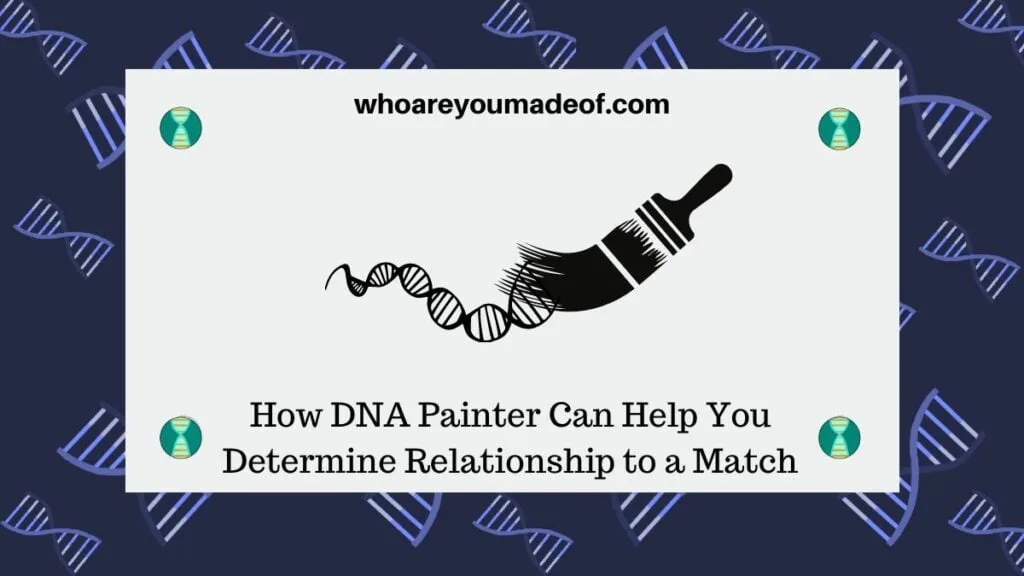
In order to illustrate how to use DNA Painter to figure out a relationship to a match, I'll walk you through my own journey to figure out how my distant cousin is related to me.
Do you have DNA matches with whom you can't find the connection?
I have a distant cousin on Ancestry who has also uploaded her DNA to Gedmatch. Since I have many fewer matches on Gedmatch, she isn't very far down my list,
I may not have noticed her as a match on Ancestry, since my list is much longer.
We share one 23.1 cM segment with each other, which could initially lead one to think that we could be somewhere between 4th-6th cousins. Upon closer examination, I realized that she also shares this same segment with my father and my grandmother.
This was helpful, since now I know that I am related through my grandmother's lines of my family tree, but the problem is that the DNA segment that she shares with my grandmother is the same size as the one that she shares with me.
This means that this segment was passed down almost completely intact from my grandmother to my dad, and now to me, and remains essentially the same size. It also means that she could be a 4th-6th cousin to my grandmother, meaning that I have to look even further back in both of our trees to find the connection.
Furthermore, it's possible that this DNA segment was inherited by my grandmother from one of her parents completely intact - making the common ancestor even further back than the segment size could lead me to believe.
Note: This is a very important lesson to learn when it comes to the size of DNA segments - size doesn't always matter (I wrote more about this phenomenon in my post about sticky DNA segments)
This cousin and I have become friends. We are Facebook friends, and we seem to get along pretty well.
I'd like to find our connection, and I decided to see if DNA Painter, the new tool I've been trying out, could help me with this mystery. For the purpose of this post, we'll refer to my cousin as "Annie", which is most definitely not her real name 😉
First steps to painting your chromosomes
In order to use DNA Painter, you will need to have access to a website that provides information about your DNA matches that has a chromosome browser. You will need a chromosome browser so you can see the exact location of each shared DNA segment on your chromosomes.
The following testing companies and websites offer a chromosome browser:
- Gedmatch (not a testing company, upload your DNA here for free)
- Family Tree DNA (testing company, but they accept transfers if you already tested your DNA somewhere else)
- My Heritage DNA (also a testing company, also accepts transfers)
You will also need to create a free DNA Painter account and a profile for yourself. It's free to create a DNA Painter account and one DNA profile for painting.
You can read a little bit about DNA Painter here if you want to learn a little more about it, though I intend to go in more detail for this post.
No matter what, but especially if you are interested in painting your chromosomes, I recommend uploading your DNA to as many websites as possible - especially those with chromosome browsers that I mentioned above.
To be useful, you should paint as many chromosomes as you can, and to do this, you need to have as many DNA matches as possible.
Which matches should you paint first on DNA Painter?
The first thing you should do after you create your profile is to paint in your known cousins. Closest cousins are most useful, but go ahead and paint in any match where you have already determined how you are related.
I have gotten into the habit of painting a new match in as soon as I figure out how they are connected. This way, my DNA Painter profile is as complete as possible and I can quickly identify how a new match may be related.
In the case of my cousin, Annie, I knew that she was related on my grandmother's side. My first task was to make sure that all of my known DNA cousins on my grandmother's side of the family are painted on to my profile.
Important: Since my grandmother and father have both done DNA tests, I had to make sure that I was using information between my own DNA results and my grandmother's cousins, not my grandmother's results compared with her cousins.
I'm painting my own chromosomes, not my grandmother's, though having access to my grandmother's results can help me figure out which line my match is on.
(I'm putting together a post on the exact steps needed to paint matches, and I'll post them here as soon as it's ready - probably within the next couple of days or so!)
How the DNA Painter magic happens
I am now ready to "paint" my match, Annie, into my DNA Painter profile. She matches me on Gedmatch, so I'll copy the details of our matching segment from the Gedmatch One-to-One comparison tool results. The information that you see highlighted in blue is what I copied (you can click "Ctrl+c" on your keyboard to copy easy without even using your mouse.
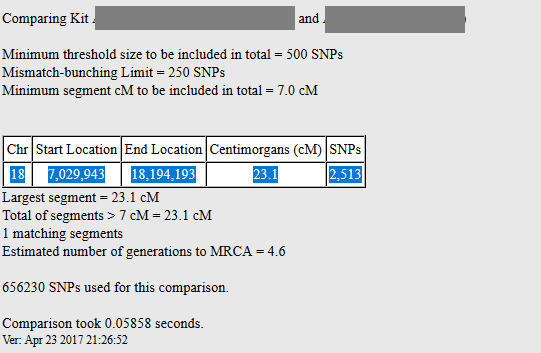
My next step will be to access my profile in DNA Painter and paint Annie into my chromosomes.
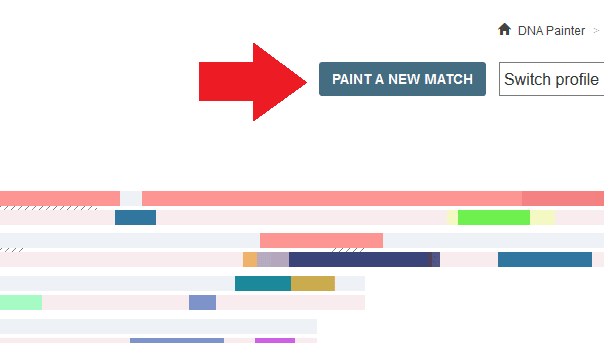
I'll just paste our copied information from our Gedmatch comparison: into the screen that pops up:
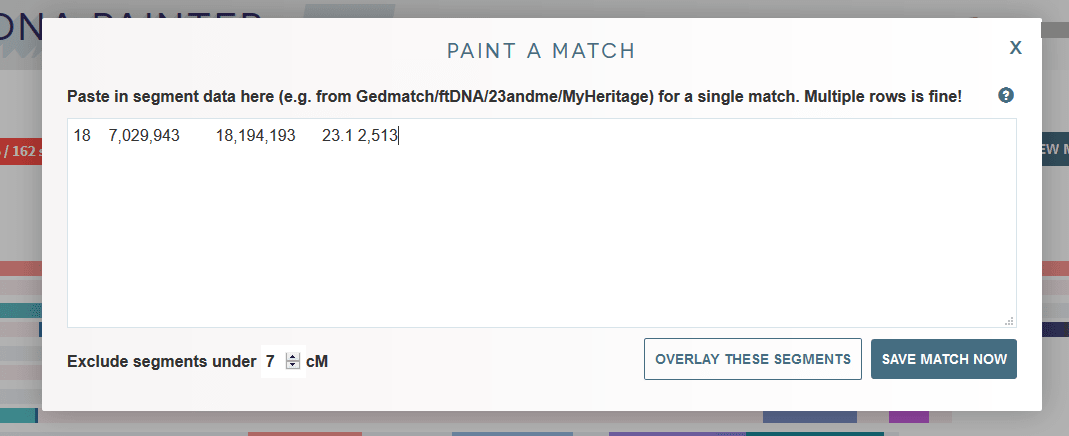
On the next screen, I have the chance to enter in information about Annie, specify which side of the family we match on, and enter information (if known) about our common ancestor:
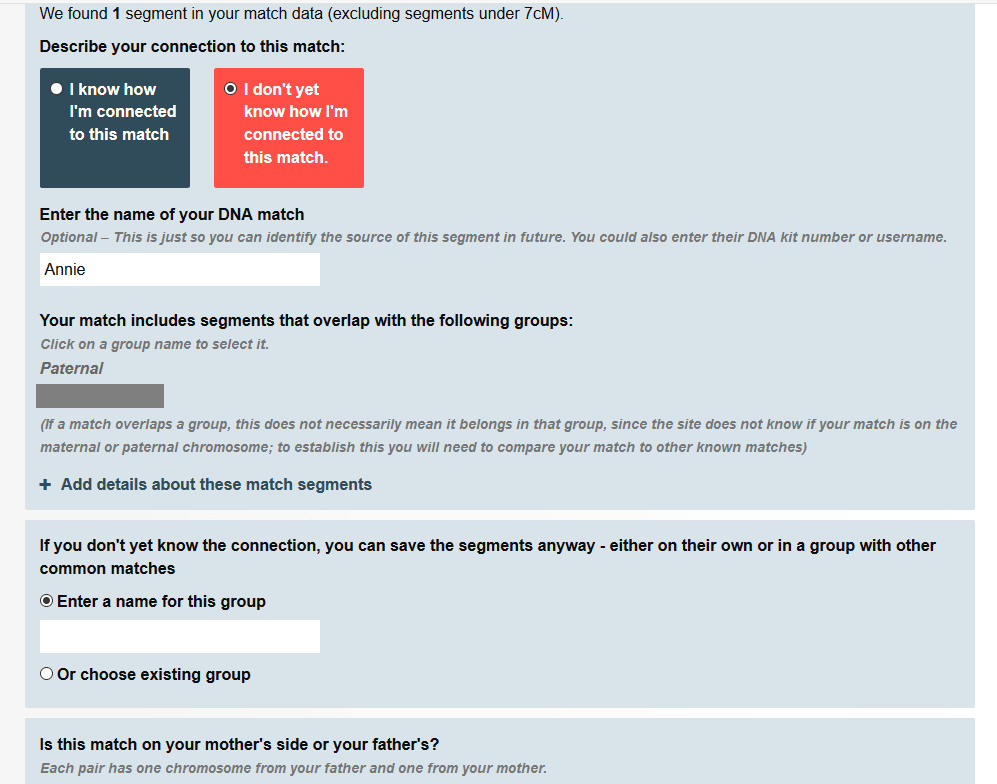
Once I click "Save" I will now see my DNA with all of the "painting" that I have done on my chromosomes. I am interested in finding out how I am related to Annie, however, and my matching segment with Annie is on my paternal copy of the 18th chromosome.
If I scroll down to Chromosome 18, this is what I see:

As you might remember, we have two copies of Chromosome 18. My maternal copy is the one with only one segment painted (the teal one), and my paternal copy has many more segments painted.
I wish I could paint all of them in, but I just don't have enough information yet. Fortunately, I do see that Annie's segment does overlap another cousin's segment. I can click on the number "18" to expand the chromosome and see the segments in more detail, along with names:
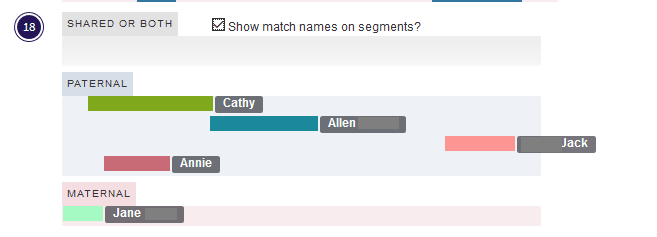
You can see clearly from the image above that Annie's segment overlaps with Cathy's segment. Cathy is my grandmother's first cousin once-removed, and I know how we are related - our common ancestor is at least as far back as my great-great-great grandparents on my grandmother's paternal grandmother's side of the family.
I feel fairly certain that it can't be those 3rd great-grandparents that Annie and I inherited our segments from. If Annie and my grandmother were more closely related, they would share much more DNA than just 23 cMs or so.
While it doesn't tell me - yet - exactly who our common ancestor is, it has narrowed down the possibilities significantly. I already knew that she was a distant cousin on my grandmother's lines, but my grandmother has 32 great-great-great grandparents, and that is a lot of ancestors to research and look through.
In other words, DNA Painter helped me figure out that Annie and I inherited this DNA segment from ancestors of my 3rd great-grandparents.
Now, I know exactly which set of great-great-great grandparents I need to be examining. Basically, I have eliminated 30 of the 32 (93.75%) of the possibilities from my list of people to research. Sweet!
The next step would be to look at our trees and see if I can narrow down a geographic area, find common surnames, and basically use more traditional genealogical methods to see exactly how we might match. I would also like to add that a 23 cM match isn't a very small segment, but there is a possibility that it has survived intact for several generations, meaning that Annie and my grandmother might be 6th-8th cousins.
I'll be honest and say that I don't know who all of my grandmother's 1000+ 8th great-grandparents are, and I doubt that Annie knows all of hers, either. This doesn't mean that we will never find our connection, but it will take more work to figure it out.
If you try this strategy with closer relatives, you will be sure to have great success! It takes time to paint enough known DNA matches into your profile to have enough information to help work out your connection to other matches, but the effort it well worthwhile.
Conclusion
I hope that this post has given you a good idea of a tangible way you could use DNA Painter. It's such a helpful tool!
If you have any questions about something that you read here, or would like to share your own experience or question related to using DNA Painter to identify a segment inherited from a particular ancestors, I would love to hear from you in the comments below.
Thanks for stopping by!

